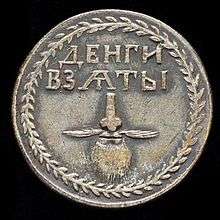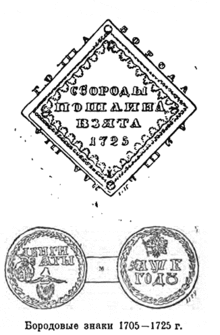Beard tax

A beard tax is one of several taxes introduced throughout history on men who wear beards.
England
In 1535, King Henry VIII of England, who wore a beard himself, introduced a tax on beards. The tax was a graduated tax, varying with the wearer's social position. His daughter, Elizabeth I of England, reintroduced the beard tax, taxing every beard of more than two weeks' growth, although it was poorly enforced.[1] Contemporary documentation of the Tudor beard tax, however, is lacking, and The National Archives has no record of such a tax having been instituted.[2]
Russia

In 1698,[3] Emperor Peter I of Russia instituted a beard tax to bring Russian society in line with Western European models. To enforce the ban on beards, the tsar empowered police to forcibly and publicly shave those who refused to pay the tax.[4] Resistance to going clean shaven was widespread with many believing that it was a religious requirement for a man to wear a beard.[5] The tax levied depended upon the status of the bearded man: Those associated with the Imperial Court, military, or government were charged 60 rubles annually; wealthy merchants were charged 100 rubles per year while other merchants and townsfolk were charged 60 rubles per year; Muscovites were charged 30 rubles per year; and peasants were charged two half-kopeks every time they entered a city.[6]
Beard token
Those who paid the tax were required to carry a "beard token" (Бородовой знак).[7] This was a copper or silver token with a Russian Eagle on the reverse and on the obverse the lower part of a face with nose, mouth, whiskers, and beard. Several different versions were minted between the issuance of the decree and its lifting in 1772.[8] The common round version was inscribed with the words "money taken" (ДЕНГИ ВЗѦТЫ) on the obverse and the date in Cyrillic numerals (҂АѰЕ ГОДѸ, "Year 1705") on the reverse. A rhomboid version issued in 1725 was smooth on the reverse with the phrase "beard tax taken" (СБОРОДЫ ПОШЛИНА ВЗЯТА) on the obverse and "the beard is a superfluous burden" (БОРОДА ЛИШНѦѦ ТѦГОТА) on the edge.[9][10] Walter Hawkins published a paper in 1845 illustrating an example of the token from his own collection, and describing the history of the tax in Russia.[11]
See also
References
- ↑ Andrews, William G. (1904). At the Sign of the Barber's Pole: Studies in Hirsute History (TXT). Cottingham, Yorkshire, England: J.R. Tutin. ISBN 978-1590210819. Retrieved 2016-12-28.
- ↑ Hawksley, Lucinda (2014-11-11). "DHH Author Blog: Moustaches, Whiskers & Beards – Lucinda Hawksley". Retrieved 2016-12-28.
- ↑ Corson, Richard (2005). Fashions in Hair: The First Five Thousand Years (3 ed.). London: Peter Owen Publishers. p. 220. ISBN 978-0720610932.
- ↑ Worthington, Daryl (2016-09-04). "History’s Strangest Tax? Peter the Great Puts a Price on Beards". New Historian. London: Forgotten Books. Retrieved 2016-12-27.
- ↑ Walsh, Devan (2015), Analysis of Peter the Great's Social Reforms and the Justification of the Reactions from the General Public (PDF), retrieved 2016-12-27
- ↑ "Указ Императора Петра I — О бритiи бородъ и усовъ всякаго чина людямъ, кромѣ поповъ и дьяконовъ, о взятiи пошлины съ тѣхъ, которые сего исполнить не захотятъ, и о выдачѣ заплатившимъ пошлину знаковъ" [Decree of Tsar Peter I — Concerning Beards and Mustaches of Certain Ranks of People, Exempting Priests and Deacons, and Levying a Fee and Issuing a Mark to Those Who Do Not Wish to Shave] (in Russian). 1705-01-16. Retrieved 2016-12-27.
- ↑ Schaffer, Jonathan (2009-11-25). "Smithsonian Rare Russian Coin Collection Seeks Exhibition Sponsor". U.S. Department of State. Archived from the original on 2011-10-13. Retrieved 2016-12-28.
- ↑ Mancini, Mark (2014-03-29). "The Time Peter the Great Declared War on Facial Hair". Mental Floss. Retrieved 2016-12-27.
- ↑ Florensky, Pavel (1997). The Pillar and Ground of the Truth: An Essay in Orthodox Theodicy in Twelve Letters. Princeton, New Jersey: Princeton University Press. p. 535. ISBN 978-0691032436.
- ↑ "Бородовой знак". Brockhaus and Efron Encyclopedic Dictionary. St. Petersburg, Russia. 1907. Retrieved 2016-12-27.
- ↑ Hawkins, Walter (1845). "Russian Beard Token". In John Yonge Akerman (ed.). The Numismatic Chronicle and Journal of the Numismatic Society. Vol. VII. London: Taylor & Walton. pp. 153–155. Retrieved 27 December 2016.
